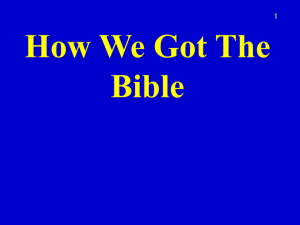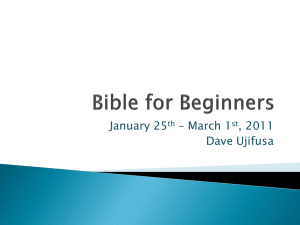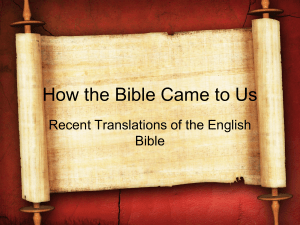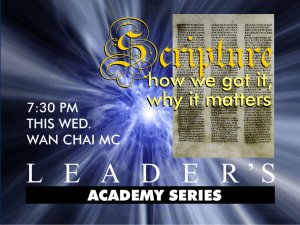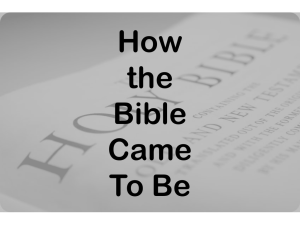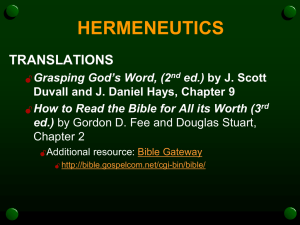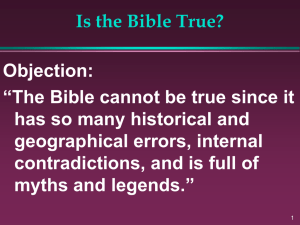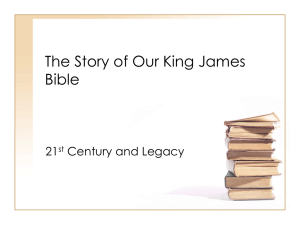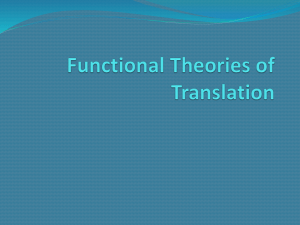Bible Translations Presentation - Greater Durban West of SDA
advertisement
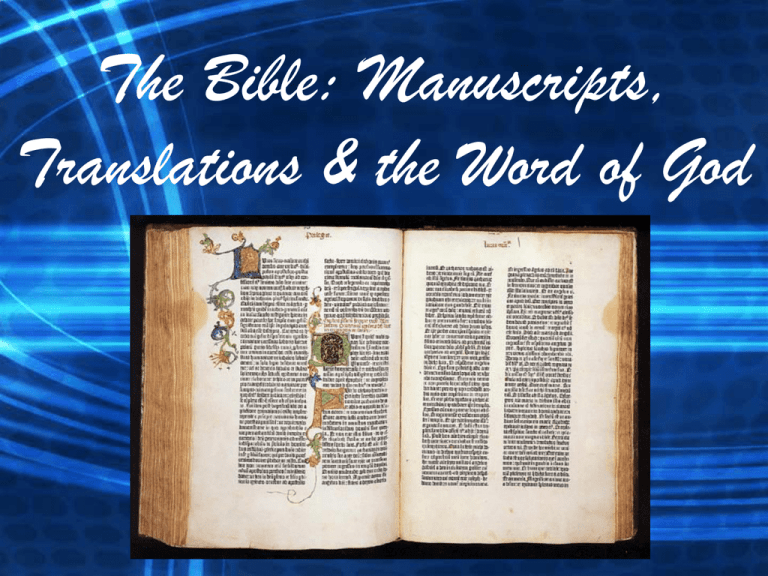
The Bible: Manuscripts, Translations & the Word of God An Illustration: A friend from Japan was telling me about the Japanese version of the Bible he uses. He turned to Luke 5:39. In the NIV this scripture reads, “And no one after drinking old wine wants the new, for he says, ‘The old is better.’” My friend told me: “My Japanese Bible does not say ‘wine.’ It says ‘sake’ [a Japanese beverage made from fermented rice]. Since new sake is better than old sake, the verse goes, ‘No one after drinking new sake wants old, for he says, ‘The new is better.’” At first glance, that translation seems the opposite of what Jesus said. He said the old was better, not the new. Also, Jesus said wine, not sake. Wine is usually better after a few years of aging. Sake is better when it is fresh. Why did the translators use the word sake instead of wine? My friend explained that in Japan, few people know about wine. Thus, the translators of the Japanese Bible were faced with a choice. Either they translate the verse literally, and confuse their readers, or they translate the verse more freely, and communicate Jesus’ intent. In this verse, Jesus was contrasting the old legalistic form of religion with the new form he brought. In English versions the old and new wine is a metaphor for these two forms of religion. In the Japanese translation, the sake metaphor conveys Jesus’ intent of there being a difference between the two. Ironically, if the translators had chosen the literal rendering, Jesus’ intended meaning would have been lost for the Japanese readers. This story illustrates a dilemma that continually haunts Bible translators. Should they translate as literally as possible, and risk confusing the reader, or should they translate the intent of the Scriptures, and thereby risk losing some of the original meaning? http://www.wcg.org/lit/bible/choosing.htm Bible Manuscripts The manuscripts written by the original authors of each book of the Bible are termed the “autographs”. None of these original documents exist today. The manuscripts that we do possess are therefore copies of copies of copies, and date to a much later time period. These manuscripts are not identical to each other. Old Testament Manuscripts • The originals were probably written over the period 1400-400 BCE. • The earliest fragments discovered to date are among the Dead Sea Scrolls: parts of Exodus and Samuel from c250 BCE. • The earliest complete book (Isaiah) comes from the same find, dating to c125 BCE. • The earliest complete copy of the whole OT, surprisingly, is a Greek translation, from c350 CE. • The earliest complete Hebrew manuscript only goes back to c950 CE. Old Testament Manuscripts A fragment of Exodus from the Dead Sea Scrolls, dating to c250 BCE. Old Testament Manuscripts 1QIsaiaha – the earliest complete book manuscript from the Old Testament, dating to c125 BCE, found in cave 1 at Qumran. Old Testament Manuscripts Codex Vaticanus – about 350 CE, contains all of the Old Testament in Greek except for a large part of Genesis and the Psalms added in the 15th century. Old Testament Manuscripts A portion of Codex Aleppo, the oldest known surviving complete manuscript of the Old Testament in Hebrew, from c950 CE. New Testament Manuscripts • The originals were probably written over the period 50 to 100 CE. • Our earliest fragment is from the Gospel of John, copied c125 CE, less than a generation after John wrote. • The oldest nearly complete copy of a whole book (also John) comes from c200 CE. • The oldest remaining complete copy of the whole NT dates from c350 CE. New Testament Manuscripts P52 – John Rylands papyrus of the Gospel of John, chapter 18, from the first third of the second century (c100-135 CE). New Testament Manuscripts P66 – Papyrus Bodmer II, an almost complete copy of the Gospel of John, from c 200 CE. New Testament Manuscripts Codex Sinaiticus – from c350 CE is the oldest complete manuscript of the New Testament. Scholars who are compiling a standardized Hebrew & Greek biblical text must evaluate and make judgements as to which manuscript reading (version of the text) is closest to the original autographs. Most manuscripts differ in only minor ways: –Spelling –Grammar –Word choice Some manuscripts do have greater variation: –Sentences (verses) –Paragraphs –Passages (chapters) Textual Basis for Bible Translations The Modern Critical Text • The text of the OT and NT as reconstructed from all presently-known manuscripts, giving greater weight to those manuscripts which are earlier and/or appear to be more reliable. • This is used in most modern versions. Variant readings are generally listed in the margin or in footnotes. A page from the Gospel of Mark in a critical edition of the Greek New Testament. What is a Translation? • • • Interpretation of the meaning of the Bible from original languages into another (modern) language Examples: King James Version, New English Version, Revised Standard Version, New American Bible, etc. Over 500 different English translations of Bible exist—as well as translations into over two thousand other languages. Literal Translation (Word-for-word) Dynamic Translation (Thought-for-thought) Free Translation (Paraphrase) Literal Translations • • • • • • A literal translation (also referred to as a “word-forword” translation) seeks to represent the original text in a more word-for-word manner. King James Version New King James Version American Standard Version New American Standard Version Revised Standard Version Young’s Literal Translation Literal Translation (Word-for-word) Dynamic Translation (Thought-for-thought) Free Translation (Paraphrase) Free Translations (Paraphrases) A paraphrase (also referred to as a “free” translation) is one which is not as concerned with original word order or sentence structure as it is the idea of the passage. This type of translation seeks to render the ideas in the original text as accurately as possible in the target language (like English). • The Clear Word • The Living Bible • The Message Literal Translation (Word-for-word) Dynamic Translation (Thought-for-thought) Free Translation (Paraphrase) Dynamic Translations • • • • • A dynamic equivalent is a translation that seeks to strike a balance between the two mentioned above. The goal of this type of translation is to render the idea conveyed by the original language into that of the target language (like English). New International Version New English Bible Revised English Bible Good News Bible Contemporary English Version Translation Styles - Luke 2:1 • And it came to pass in those days, that there went out a decree from Caesar Augustus, that all the world should be taxed (KJV, rather literal). • Now it came about in those days that a decree went out from Caesar Augustus, that a census be taken of all the inhabited earth (NASB, even more literal). • In those days Caesar Augustus issued a decree that a census should be taken of the entire Roman world (New English Bible, dynamic). • About this time Caesar Augustus, the Roman emperor, decreed that a census should be taken throughout the nation (Living Bible, paraphrase). Translation Styles - Proverbs 10:11 • A fountain of life is the mouth of the righteous, And the mouth of the wicked cover doth violence. (Young’s Literal Translation). • The mouth of the righteous is a fountain of life, but the mouth of the wicked conceals violence (NASB also NRSV). • The mouth of the righteous is a fountain of life, but violence overwhelms the mouth of the wicked (NIV). • There is living truth in what a good man says, but the mouth of the evil man is filled with curses (Living Bible). Translation Styles – Revelation 21:1 • And I saw a new heaven and a new earth, for the first heaven and the first earth did pass away, and the sea is not any more. (Young’s Literal Translation). • Then I saw a new heaven and a new earth; for the first heaven and the first earth had passed away, and the sea was no more. (NRSV). • Then I saw a new heaven and a new earth. The first heaven and first earth disappeared, and the sea vanished. (Good News Bible) • I saw the first Heaven and earth new-created. Gone the first Heaven, gone the first earth, gone the sea. (The Message). Translation Styles – John 1:1 • In the beginning was the Word, and the Word was with God, and the Word was God (NASB). • When all things began, the Word already was. The Word dwelt with God, and what God was, the Word was (NEB). • The Word was first, the word present to God, God present to the Word. The Word was God, in readiness for God from day one. (The Message) The theological outlook of a translator can also influence a translation. • In the beginning the Word was, and the Word was with God, and the Word was a god (New World Translation, Jehovah’s Witnesses). No Perfect Translation Exists • Important recent discoveries of older manuscripts – Codex Sinaiticus (written 350-400 BCE, found 1859) – Dead Sea Scrolls (written before 100 CE, found 1947-1956 • Meanings of some biblical texts remain unknown/uncertain • Every “translation” is an “interpretation” • Cultural developments require new sensitivities in language • inclusive language alternatives What did Ellen White have to say on the subject of Bible Translations? “In her writings of the Holy Scriptures Ellen White made use of the various English translations of the Holy Scriptures that were available in her day. She does not, however, comment directly on the relative merits of these versions, but it is clear from her practice that she recognized the desirability of making use of the best in all versions of the Bible.” Arthur L. White, “The E. G. White Counsel on Versions of the Bible” Available at: http://www.whiteestate.org/issues/Versions.html On Ellen White’s attitude toward the English revision of the 1880’s, W. C. White, reported: “Before the revised version was published, there leaked out from the committee, statements regarding changes which they intended to make. Some of these I brought to Mother’s attention, and she gave me very surprising information regarding these Scriptures. This led me to believe that the revision, when it came to hand, would be a matter of great service to us.” W. C. White, DF 579 (1931); Ministry, April, 1947, p. 17. It is significant that almost immediately after the appearance of the English Revised Version, Ellen White made use of it in her books, as she did also of the American Standard Revision when it became available in 1901. As noted earlier, Ellen White occasionally used the Revised Version renderings, also the marginal reading of texts, in nearly all of her books published after 1885, the year of the appearance of the complete English Revised Version. In The Great Controversy, published in 1888, seven texts from the newly issued revision were employed, and she also used the marginal rendering of eight other texts….In 1901 the American Revised Version came from the press, and from that time forward we find that Ellen White occasionally employed both the English Revised and the American Revised versions. In 1911, when The Great Controversy was reset, Ellen White retained six of the seven texts previously quoted from the English Revised Version. For the other text she substituted the American Revised rendering. The eight marginal renderings were used as in the earlier edition. In the publication of The Ministry of Healing (1905) Ellen White employed eight texts from the English Revised Version, 55 from the American Revised Version, two from Leeser, and four from Noyes, in addition to seven marginal renderings. Other books in which Revised Version texts frequently appear are Patriarchs and Prophets (1890); Steps to Christ (1892); Thoughts From the Mount of Blessing (1896); The Desire of Ages (1898); Education (1903); and Testimonies for the Church, 8 (1904). Other books using a few Revised Version or marginal renderings are Christ’s Object Lessons (1900); Testimonies for the Church, 7 (1902) & 9 (1909); The Acts of the Apostles (1911); and Prophets and Kings (1917). Patriarchs and Prophets (1890) also contains two renderings from the Bernard translation, and at least one from the Boothroyd Version. Education (1903) contains at least one rendering from the Rotherham translation. W. C. White wrote in 1931: “I do not know of anything in the E. G. White writings, nor can I remember of anything in Sister White’s conversations, that would intimate that she felt that there was any evil in the use of the Revised Version....She referred to it occasionally, but never used it in her preaching….We cannot find in any of Sister White’s writings, nor do I find in my memory, any condemnation of the American Revised Version of the Holy Scriptures.” White Estate DF 579; Ministry, April, 1947, pp. 17, 18. But What About the King James Version? Any Bible version’s accuracy depends on more than its translators’ skill. Accuracy also depends on the translators’ choice of the original Bible text. Significant advances in textual studies have been made since the 1611 King James Version. “The King James translators had seven Greek manuscripts of the New Testament available to them,” says Ken Barker. “Today, we have more than 5,000 manuscripts and papyri discovered since 1611.” The King James Version also contains obsolete (no longer used) words like: champaign, churl, cieled, clouted, cockatrice, collops, cotes, daysman, goodlier, firstlings, damsel, wimples, wrought, wot, wist, froward, brigadine, amerce, blains, crookbact, descry, fanners, glede, habergeon, implead, neesing, nitre, rereward, tabret, tabering and wen. The King James Version also uses words that have changed their meaning. In the seventeenth century: ‘allege’ was used for ‘prove,’ ‘communicate’ for ‘share,’ ‘suffer’ for ‘allow,’ ‘allow’ for ‘approve,’ ‘let’ for ‘hinder,’ ‘prevent’ for ‘precede,’ ‘conversation’ for ‘conduct,’ Etc. Is the King James Version perfect? NO. Is it more accurate than all other versions? NO. Is it a bad version? NO. The King James Version has been a favourite translation for nearly 400 years. However it is not based on the oldest and most accurate manuscripts, and its Elizabethan style Old English is difficult for many modern readers. Which Version Should I Choose? Accuracy: • Group translations are generally less subject to bias than individual translations. (Message, The Clear Word, The Living Bible) • Interdenominational translations are generally less subject to bias than denominational translations. (The Clear Word, The New World Translation—Jehovah’s Witnesses) • Modern translations have the advantage of access to recent archaeological discoveries, technology, & research. Which Version Should I Choose? Intended Purpose: • Paraphrases often have a natural, easy-to-read flow. They enable you to easily read a book of the Bible in a few sittings to get an overview of what is discussed. These translations can also be quite thought-provoking. They often convey an emotion that may be lost in more rigid translations. • A literal translation generally takes more time to read because of some awkward wordings. However, if you are doing serious study of the Bible, including grammar and vocabulary, you will want a more literal translation. Which Version Should I Choose? Personal Preference: • Which version are you used to? • Are you comfortable with level & style of language used? Intended Audience: • If you plan to read the Bible with children or young people, the CEV, the NLT, the NIV, or the GNT are very good choices. The language in these tends to more readable and modern. These translations also avoid some of the difficult phrases and words you often find in other translations. This also makes them excellent choices to use with anyone not familiar with the Bible. Which Version Should I Choose? • • • Don’t be afraid to try a new or unfamiliar version. You may be surprised at what insights the new version brings to your understanding. Don’t be afraid that a new or different version is unreliable, corrupted, or somehow not God’s word. Apart from versions with obvious denominational biases—like The New World Translation—this does not reflect reality. Don’t rely on any single version. Every translation reflects the biases of its translators. For this reason, you will learn more in your Bible study if you regularly consult other versions. A good technique is to refer to at least two other Bible versions—one of them more literal and the other more thought-for-thought. An anecdote about Billy Graham contains perhaps the best advice about Bible versions. According to the story, Billy Graham was once asked which Bible version is the best. “The one you read,” he replied.
